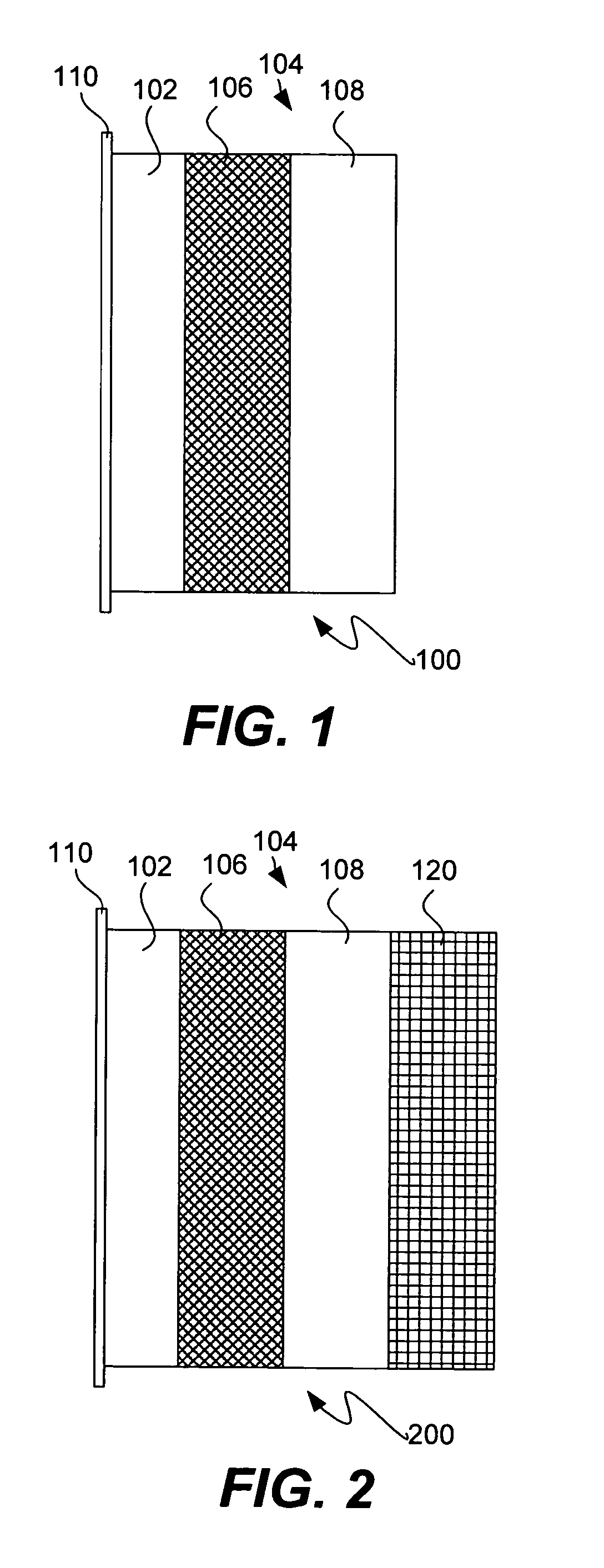Protected active metal electrode and battery cell structures with non-aqueous interlayer architecture
a technology of active metal electrodes and battery cells, applied in the direction of non-aqueous electrolyte cells, cell components, sustainable manufacturing/processing, etc., can solve the problems of failure of rechargeable lithium metal batteries
- Summary
- Abstract
- Description
- Claims
- Application Information
AI Technical Summary
Benefits of technology
Problems solved by technology
Method used
Image
Examples
example 1
[0088]A series of experiments was performed in which the commercial ionically conductive glass-ceramic from OHARA Corporation was used as a membrane separating aqueous catholyte and non-aqueous anolyte. The cell structure was Li / non-aqueous electrolyte / glass-ceramic / aqueous electrolyte / Pt. A lithium foil from Chemetall Foote Corporation with thickness of 125 microns was used as the anode. The GLASS-CERAMIC plates were in the range of 0.3 to 0.48 mm in thickness. The GLASS-CERAMIC plate was fitted into an electrochemical cell by use of two o-rings such that the GLASS-CERAMIC plate was exposed to an aqueous environment from one side and a non-aqueous environment from the other side. In this case, the aqueous electrolyte comprised an artificial seawater prepared with 35 ppt of “Instant Ocean” from Aquarium Systems, Inc. The conductivity of the seawater was determined to be 4.5 10−2 S / cm. A microporous Celgard separator placed on the other side of the GLASS-CERAMIC was f...
example 2
Li / Air Cell
[0089]The cell structure was similar to that in the previous example, but instead of a Pt electrode completely immersed in the electrolyte, this experimental cell had an air electrode made for commercial Zn / Air batteries. An aqueous electrolyte used was 1 M LiOH. A Li anode and a non-aqueous electrolyte were the same as described in the previous example.
[0090]An open circuit potential of 3.2 V was observed for this cell. FIG. 5 shows discharge voltage-time curve at discharge rate of 0.3 mA / cm2. The cell exhibited discharge voltage of 2.8-2.9 V. for more than 14 hrs. This result shows that good performance can be achieved for Li / air cells with solid electrolyte membrane separating aqueous catholyte and non-aqueous anolyte.
example 3
[0091]In these experiments the commercial ionically conductive glass-ceramic from OHARA Corporation was used as a membrane separating aqueous catholyte and non-aqueous anolyte. The cell structure was carbon / non-aqueous electrolyte / glass-ceramic plate / aqueous electrolyte / Pt. A commercial carbon electrode on copper substrate comprising a synthetic graphite similar to carbon electrodes commonly used in lithium-ion batteries was used as the anode. The thickness of the glass-ceramic plate was 0.3 mm. The glass-ceramic plate was fitted into an electrochemical cell by use of two o-rings such that the glass-ceramic plate was exposed to an aqueous environment from one side and a non-aqueous environment from the other side. The aqueous electrolyte comprised 2 M LiCl and 1 M HCl. Two layers of microporous Celgard separator placed on the other side of the glass-ceramic were filled with non-aqueous electrolyte comprised of 1 M LiPF6 dissolved in the mixture of ethylene carbonate and d...
PUM
| Property | Measurement | Unit |
|---|---|---|
| ionic conductivity | aaaaa | aaaaa |
| voltage | aaaaa | aaaaa |
| breakdown voltage | aaaaa | aaaaa |
Abstract
Description
Claims
Application Information
 Login to View More
Login to View More - R&D
- Intellectual Property
- Life Sciences
- Materials
- Tech Scout
- Unparalleled Data Quality
- Higher Quality Content
- 60% Fewer Hallucinations
Browse by: Latest US Patents, China's latest patents, Technical Efficacy Thesaurus, Application Domain, Technology Topic, Popular Technical Reports.
© 2025 PatSnap. All rights reserved.Legal|Privacy policy|Modern Slavery Act Transparency Statement|Sitemap|About US| Contact US: help@patsnap.com



